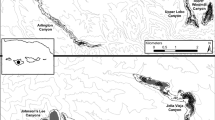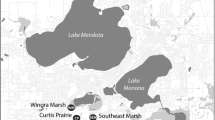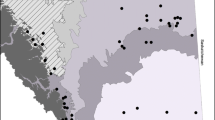Abstract
Despite the detrimental impacts of invasive plants on native biodiversity, ecosystem function, and management cost, few studies have focused on the long-term persistence of invaders. Here, we use a unique, long-term dataset to examine the recovery of northern rough fescue prairie communities, 41 years after the removal of livestock from Riding Mountain National Park, Manitoba, Canada. Our 1973 data suggest that summer grazing of plains’ rough fescue (Festuca hallii (Vasey) Piper) leads to its displacement from the plant community and increased dominance by exotic invaders. After 41 years of recovery time, historic grazing intensity remained an excellent predictor of community structure and composition. Areas classified as heavily grazed in 1973 remained characterized by exotic grasses and had significantly lower richness and diversity. While some exotic invaders persisted despite 41 years of community recovery, others were ephemeral. For example, both Poa pratensis (L.) and Bromus inermis (Leyss.) persisted, increasing in abundance across all classes of grazing intensity, suggesting that their control requires active restoration of the invaded areas. In contrast, passive restoration may be possible for a subset of ephemeral exotic species such as Taraxacum officinale, which had virtually disappeared from invaded prairies by 2010. Our long-term data provide a rare perspective into the long-term dynamics of plant invasions. Based on our findings, conservation managers will need to consider the dichotomy between persistent and ephemeral invaders and their impact on the recovery of northern prairie communities as they focus their restoration efforts against the mounting impacts of exotic plant invaders.




Similar content being viewed by others
References
Ahern RG, Landis DA, Reznicek AA, Schemske DW (2010) Spread of exotic plants in the landscape: the role of time, growth habit, and history of invasiveness. Biol Invasions 12:3157–3169
Bahm MA, Barnes TG, Jensen KC (2011) Herbicide and fire effects on smooth brome (Bromus inermis) and Kentucky bluegrass (Poa pratensis) in invaded prairie remnants. Invasive Plant Sci Manag 4:89–197
Blankspoor GW, Larson EA (1994) Response of smooth brome (Bromus inermis Leyss.) to burning under varying soil moisture conditions. Am Midl Nat 131:266–272
Blood DA (1966a) The Festuca scabrella association in Riding Mountain National Park, Manitoba. Can Field Nat 80:24–32
Blood DA (1966b) Range relationships of elk and cattle in Riding Mountain National Park, Manitoba. Canadian Wildlife Service Wildlife Management Bulletin Series 1. No. 19
Blumenthal DM, Jordan NR, Svenson EL (2005) Effects of prairie restoration on weed invasions. Agric Ecosyst Environ 107:221–230
Brouillet L, Coursol F, Favreau M, Anions M, Bélisle P, Desmet P (2010) +VASCAN, the database of vascular plants of Canada. http://data.canadensys.net/vascan/. Accessed 23 Oct 2011
Buckling A, Kassen R, Bell G, Rainey PB (2000) Disturbance and diversity in experimental microcosms. Nature 408:961–964
Colautti RI, Bailey SA, van Overdijk CDA, Amundsen K, MacIsaac HJ (2006) Characterized and projected costs of nonindigenous species in Canada. Biol Invasions 8:45–59
Crawley MJ (1987) What makes a community invasible? In: Gray AJ, Crawley MJ, Edwards PJ (eds) Colonization, succession, and stability. Blackwell, Oxford
D’Antonio CM, Vitousek PM (1992) Biological invasions by exotic grasses, the grass/fire cycle, and global change. Ann Rev Ecol Syst 23:63–87
Davies KW (2011) Plant community diversity and native plant abundance decline with increasing abundance of an exotic annual grass. Oecologia 167:481–491
Davis MA (2003) Biotic globalization: does competition from introduced species threaten biodiversity? Bioscience 53:481–489
Davis MA, Grime J, Thompson K (2000) Fluctuating resources in plant communities: a general theory of invasibility. J Ecol 88:528–534
de Albuquerque FS, Castro-Diez P, Rueda M, Hawkins BA, Rodriguez MA (2011) Relationships of climate, residence time, and biogeographical origin with the range sizes and species richness patterns of exotic plants in Great Britain. Plant Ecol 212:1901–1911
Department of the Interior (1921) Report of the director of forestry for the year 1921. Government Printing Bureau, Ottawa
Dietz H, Edwards PJ (2006) Recognition that causal processes change during plant invasion helps explain conflicts in evidence. Ecology 87:1359–1367
DiVittorio CT, Corbin JD, D’Antonio C (2007) Spatial and temporal patterns of seed dispersal: an important determinant of grassland invasion. Ecol Appl 17:311–316
Fansler VA, Mangold JM (2011) Restoring native grass to crested wheatgrass stands. Restor Ecol 19:16–23
Forcella F, Harvey SJ (1983) Relative abundance in an alien weed flora. Oecologia 59:292–295
Frank DA, McNaughton SJ (1992) The ecology of plants, large mammalian herbivores, and drought in Yellowstone National Park. Ecology 73:2043–2058
Frank AB, Tanaka DL, Hofmann L, Follett RF (1995) Soil carbon and nitrogen of northern great plains grasslands as influenced by long-term grazing. J Range Manag 48:470–474
Gerling HS, Bailey AW, Willms WD (1995) The effects of burning on Festuca hallii in the parklands of central Alberta. Can J Bot 73:937–942
Grant TA, Flanders-Wanner B, Shaffer TL, Murphy RK, Knutsen GA (2009) An emerging crisis across northern prairie refuges: prevalence of invasive plants and a plan for adaptive management. Ecol Restor 27:58–65
Grilz PL, Romo JT (1994) Water relations and growth of Bromus inermis Leyss. (smooth brome) following spring or autumn burning in a fescue prairie. Am Midl Nat 132:340–348
Hill MO (1973) Diversity and evenness: a unifying notation and its consequences. Ecology 54:427–432
Hobbs NT, Baker DL, Ellis JE, Swift DM (1981) Composition and quality of elk winter diets in Colorado. J Wildl Manag 45:156–171
Holl KD, Aide TM (2011) When and where to actively restore ecosystems? For Ecol Manag 261:1558–1563
Hull RJ (1987) Kentucky bluegrass photosynthate partitioning following scheduled mowing. J Am Soc Hortic Sci 112:829–834
Johnston A, MacDonald MD (1967) Floral initiation and seed production in Festuca scabrella Torr. Can J Plant Sci 47:577–583
Johnston A, Dormaar JF, Smoliak S (1971) Long-term grazing effects on fescue grassland soils. J Range Manag 24:185–188
Kenkel NC (2006) On selecting an appropriate multivariate analysis. Can J Plant Sci 86:663–676
Kvalseth TO (1991) Note on biological diversity, evenness, and homogeneity measures. Oikos 62:123–127
Lang AH (1974) Guide to the geology of Riding Mountain National Park and its vicinity. History of its upland and other scenery. The geological survey of Canada. Department of Energy, Mines, and Resources, Ottawa
Leeson JY, Thomas AG, Hall LM, Brenzil CA, Andrews T, Brown KR, van Acker RC (2005) Prairie weed surveys of cereal, oilseed, and pulse crops from the 1970s to the 2000s. Agriculture and Agri-Food Canada, Saskatoon Research Centre, Saskatoon
Legendre P, Legendre L (1998) Numerical ecology, 2nd English edition. Elsevier, Amsterdam
Li C, Hao X, Willms WD, Zhao M, Han G (2009) Seasonal response of herbage production and its nutrient and mineral contents to long-term cattle grazing on a rough fescue grassland. Agric Ecosyst Environ 132:32–38
MacIsaac HJ, Grigorovich IA, Ricciardi A (2001) Reassessment of species invasions concepts: the Great Lakes basin as a model. Biol Invasions 3:405–416
McIntosh T, Murray D (2004) Winter food habits of elk (Cervus elaphus) in Riding Mountain National Park, Manitoba. technical report, Parks Canada. Ottawa
McKinney ML (2002) Influence of settlement time, human population, park shape and age, visitation and roads on the number of alien plant species in protected areas in the USA. Divers Distrib 8:311–318
Moisey DM, Bork EW, Willms WD (2005) Non-destructive assessment of cattle forage selection: a test of skim grazing in fescue grassland. Appl Anim Behav Sci 94:2005–2222
Murrell DJ, Purves DW, Law R (2001) Uniting pattern and process in plant ecology. Trends Ecol Evol 16:529–530
Otfinowski R, Kenkel NC (2008) Clonal integration facilitates the proliferation of smooth brome clones invading northern fescue prairies. Plant Ecol 199:235–242
Otfinowski R, Kenkel NC (2009) Covariance between disturbance and soil resources dictates the invasibility of northern fescue prairies. Biol Invasions 12:1349–1361
Otfinowski R, Kenkel NC, Catling PM (2007) The biology of Canadian weeds. 134. Bromus inermis Leyss. Can J Plant Sci 87:183–198
Peper J, Jansen F, Pietzsch D, Manthey M (2011) Patterns of plant species turnover along grazing gradients. J Veg Sci 22:457–466
Perrins J, Fitter A, Williamson M (1993) Population biology and rates of invasion by three introduced Impatiens species in the British Iles. J Biogeogr 20:33–44
Rejmanek M, Richardson DM, Pysek P (2005) Plant invasions and invisibility of plant communities. In: der Maarel Van (ed) Vegetation ecology. Blackwell Scientific Publications, Oxford
Ringstorm E (1981) Riding Mountain yesterday and today. The Prairie Publishing Company, Winnipeg
Rosenzweig ML (2001) The four questions: what does the introduction of exotic species do to diversity? Evol Ecol Res 3:361–367
Rowe JS (1972) Forest regions of Canada. Canadian Forestry Service, Department of the Environment, Ottawa
Salesman JB, Thomsen M (2011) Smooth brome (Bromus inermis) in tallgrass prairies: a review of control methods and future research directions. Ecol Restor 29:374–381
Sinkins P (2010) Fire effects monitoring in the grasshopper valley of Riding Mountain National Park, Manitoba. technical report, Parks Canada. Ottawa
Stewart-Wade SM, Neumann S, Collins LL, Boland GJ (2002) The biology of Canadian weeds. 117. Taraxacum officinale G. H. Weber ex Wiggers. Can J Plant Sci 82:825–853
Thompson K, Davis MA (2011) Why research on traits of invasive plants tells us very little. Trends Ecol Evol 26:155–156
Trottier GC (1986) Disruption of rough fescue, Festuca hallii, grassland by livestock grazing in Riding Mountain National Park, Manitoba. Can Field Nat 100:488–495
Trottier GC, Rollins SR, Huchinson RC (1980) Range, habitat, and foraging relationships of ungulates in Riding Mountain National Park. Large mammal system studies report #14. Canadian Wildlife Service
Turkington R, Bourdon JJ (1983) The biology of Canadian weeds. 54. Trifolium repens L. Can J Plant Sci 63:243–266
Uchytil RJ (1993) Poa pratensis. In: Fire effects information system [Online]. US Department of Agriculture, Forest Service, Rocky Mountain Research Station, Fire Sciences Laboratory (producer). Available: http//ww.fs.fed.us/database/feis. Accessed 3 Oct 2011
Usher MB (1988) Biological invasions of nature reserves: a search for generalisations. Biol Cons 44:119–135
Vilà M, Basnou C, Pyšek P, Josefsson M, Genovesi P, Gollasch S, Nentwig W, Olenin S, Roques A, Roy D, Hulme PE (2009) How well do we understand the impacts of alien species on ecosystem services? A pan-European, cross-taxa assessment. Front Ecol Environ 8:135–144
Vilà M, Espinar JL, Hejda M, Hulme PE, Jarošik V, Maron JL, Pergl J, Schaffner U, Sun Y, Pyšek P (2011) Ecological impacts of invasive alien plants: a meta-analysis of their effects on species, communities and ecosystems. Ecol Lett 14:702–708
Williamson M, Fitter A (1996) The varying success of invaders. Ecology 77:1661–1666
Willms WD, Smoliak S, Dormaar JF (1985) Effects of stocking rate on a rough fescue grassland vegetation. J Range Manag 38:220–225
Yurkonis KA, Meriners SJ, Wachholder BE (2005) Invasion impacts diversity through altered community dynamics. J Ecol 93:1053–1061
Zar JH (1999) Biostatistical analysis. Prentice Hall, Upper Saddle River
Acknowledgments
All funding and support was provided by Parks Canada. Of particular importance was the data from 1973, collected by Gary Trottier, which was supplied by Riding Mountain National Park. The authors would also like to thank Dr. Norm Kenkel, and field assistance by Stephen Cornelson, Wybo Vanderschuit, Tom Christianson, Angela Spooner and Foster Karcha. Discussions with Dr. Marcel Rejmánek and Doug Bergeson provided valuable information for our work.
Author information
Authors and Affiliations
Corresponding author
Rights and permissions
About this article
Cite this article
Sinkins, P.A., Otfinowski, R. Invasion or retreat? The fate of exotic invaders on the northern prairies, 40 years after cattle grazing. Plant Ecol 213, 1251–1262 (2012). https://doi.org/10.1007/s11258-012-0083-8
Received:
Accepted:
Published:
Issue Date:
DOI: https://doi.org/10.1007/s11258-012-0083-8




